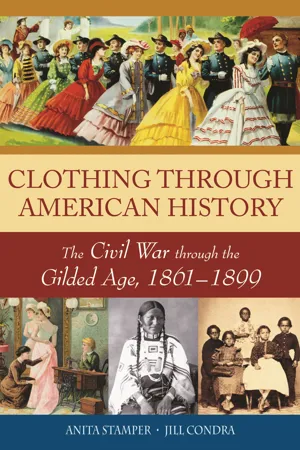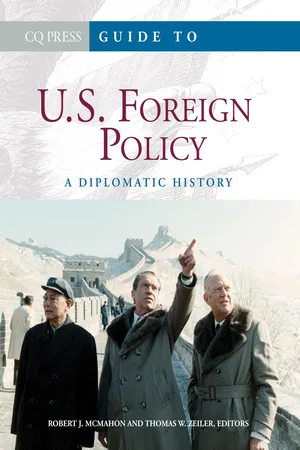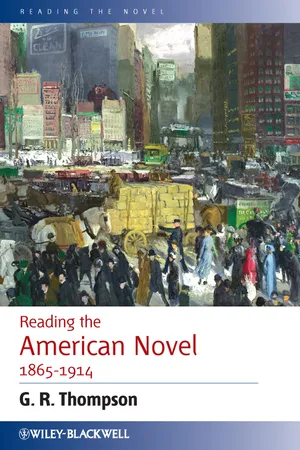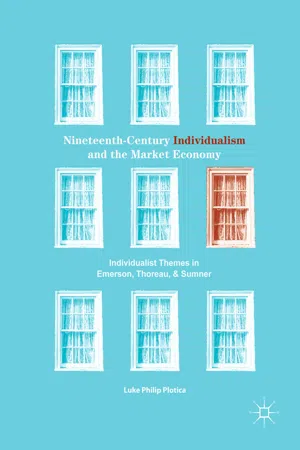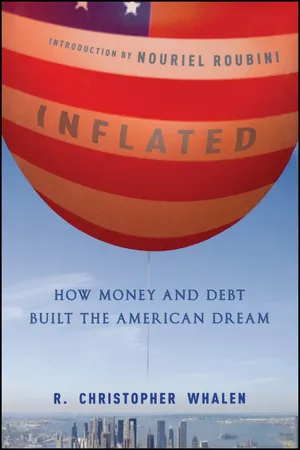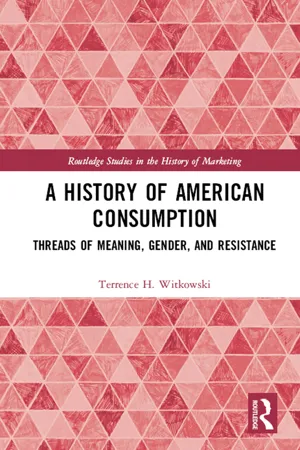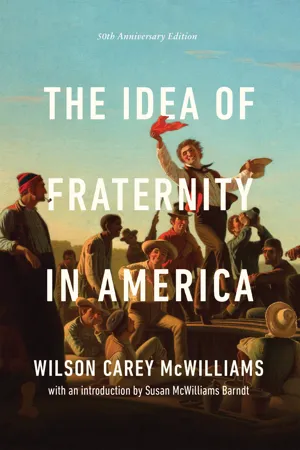History
American Gilded Age
The American Gilded Age refers to the period in the late 19th century characterized by rapid industrialization, economic growth, and ostentatious displays of wealth. It was a time of great prosperity for some, but also marked by widespread poverty, labor unrest, and political corruption. The term "gilded" suggests a thin layer of gold covering underlying social problems and inequalities.
Written by Perlego with AI-assistance
Related key terms
1 of 5
9 Key excerpts on "American Gilded Age"
- eBook - PDF
Clothing through American History
The Civil War through the Gilded Age, 1861–1899
- Anita Stamper, Jill Condra(Authors)
- 2010(Publication Date)
- Greenwood(Publisher)
This page intentionally left blank CHAPTER 6 The United States in the Gilded Age, 1877–1899 Entrepreneurs, robber barons, industrial growth, mass immigration, urban expansion, railroad development, and consumerism all marked the period in the United States known as the Gilded Age. The old puritan strictures were being quickly and thoroughly abandoned in the new economy, where luxury was something to be admired and consuming products was what many people felt defined their worth. The West was open to those who dared venture to find wealth in oil, lumber, gold, and cattle, and the railways were being built to accommodate the wave of people making their way West. Men with money had power. The great changes in industry produced a lot of wealth for a few notable families who became the toast of New York and other large cities at the time and ruled the social world within. Andrew Carnegie, a steel man; John D. Rockefeller, an oil man J. P. Morgan, of the finance and banking sec- tor; the Astor family, of real estate wealth; and the Vanderbilt family, who were leaders in shipping and railways, are a few notable names of the Gilded Age. Snobbery was raised to new heights as these families competed to achieve greater social notoriety and higher social status and influence at the highest rungs of society. From 1876 to 1900, society became much more diverse, not only with the help of vast differences between the rich and poor in the United States but also with the influx of the varied ethnic groups flock- ing to the shores of a free nation from Europe and Asia, making the 231 face of United States drastically different from earlier in the nineteenth century. Wealthy and largely white leaders of industry were joined by an ethnically diverse working class who populated the factories and built the railroads joining East and West. Within the working class, tension developed between the industrialist owners and the workers, which lead to strikes and the development of labor movements. - eBook - PDF
Guide to U.S. Foreign Policy
A Diplomatic History
- Robert J. McMahon, Thomas W. Zeiler, Robert J. McMahon, Thomas W. Zeiler(Authors)
- 2012(Publication Date)
- CQ Press(Publisher)
51 ★ b y N i c o l e M . P h e l p s c h a p t e r 4 The Gilded Age D uring the Gilded Age, the period from the end of the Civil War (1861–1865) through the mid-1890s, Americans were faced with dramatic changes that prompted many to recon-sider their place in the world and what it meant to be American. Mid-nineteenth-century technological innova-tions prompted dramatic economic growth and industrial-ization in the United States, and it also produced a strong interest in international trade. Industrialization, plus the end of slavery, prompted the development of new labor condi-tions. Domestically, those conditions produced a pro-nounced class system. Abroad, it produced a foreign policy that was remarkably close to imperialism, though instead of direct political control, U.S. leaders stressed the development of close economic ties, a process facilitated by a reinvigorated Monroe Doctrine, which claimed the Western Hemisphere as a zone of exclusive U.S. influence. In 1898, the United States became a formal empire, following the British exam-ple by strengthening its navy to guarantee its economic and political global power. Americans also embraced key aspects of the Great Power diplomatic system, expanding their dip-lomatic and consular presence overseas and participating in major international conferences and dispute resolutions. The key idea for Americans’ understanding of their position in the world during the Early National period was the antithesis between the New World and the Old, but in the Gilded Age, that idea was giving way to the concept of “civilization.” Rather than seeing themselves as the oppo-site of Europeans, many Americans came to see themselves as part of the same advanced culture and society as Europe, and the new antithesis was “barbarism,” which could be found among the lower classes and dark-skinned people around the globe. - eBook - ePub
- G. R. Thompson(Author)
- 2011(Publication Date)
- Wiley-Blackwell(Publisher)
Chapter 16 The “Gilded Age” Genteel Critics and Militant MuckrakersThe Gilded Age (1873) by Mark Twain and Charles Dudley Warner gave the Age of Big Business one of its most memorable labels. In American cultural history, the term “Gilded Age” invokes the period from the end of the Civil War through the 1890s, and slightly beyond. Associated with the rapid rise of Big Business are the Labor Movement, the Factory System, and the attempt of Corporate Capital (personified as the Robber Barons) to control it all – by violence if necessary. Within this time frame, political historians have identified other periods, most notably Reconstruction and the Progressive Era, terms embodying the contradictory tendencies of the times. But for most literary scholars and cultural critics, the “Gilded Age” is the label that has stuck.1The term emphasizes the problems and evils of laissez-faire capitalism. Gilded means covered with a thin layer of (usually) fake gold. In their comic Dickensian way, Twain and Warner strip away the pretty surface and expose the ugliness beneath the top layer of society, politics, and business. The word gilded also suggests American Victorian respectability and artifice, from the gilt-edges and decorations of fake books in simulated libraries, to elaborate gilded picture frames in over-decorated parlors, to insincere piety regarding personal behavior and business ethics.Novels of social criticism in the era generally took one of two forms: “genteel criticism” and “muckraking.” Among the Genteel Critics and historical romancers who sometimes cast a jaundiced eye on American manners, morals, and institutions are Henry Adams, Booth Tarkington, Winston Churchill, Robert Herrick, and W. D. Howells. The Muckrakers wrote both fiction and nonfiction in which they more militantly exposed the ugly underside of American capitalism and putative democracy. Important muckraking works include novels by Rebecca Harding Davis, John William De Forest, and David Graham Phillips; and journalistic exposés by Ida Tarbell, Lincoln Steffens, Jacob Riis, Thorstein Veblen, and Helen Hunt Jackson. The most famous of the American muckraking novels is Upton Sinclair's The Jungle - eBook - ePub
Nineteenth-Century Individualism and the Market Economy
Individualist Themes in Emerson, Thoreau, and Sumner
- Luke Philip Plotica(Author)
- 2017(Publication Date)
- Palgrave Macmillan(Publisher)
Though not every Gilded Age American shared this worldview, in whole or in part, both its articulations and its nonetheless widespread embrace offer a glimpse of objective conditions and the subjective understandings woven around them. By and large, the age of industrialization and corporatization was optimistic, energetic, and ambitious, yet unstable, disorienting, and anxious. The undeniable advances of science and technology, and the “tough-minded,” empirical mindset they signified, reassured and reoriented the perennial yearning for moral order, for a sense that we can know and achieve what is valuable in life (James 1907 / 1995, Lecture I). Decades after the Second Great Awakening had reinvigorated the spirituality and millennial expectations of countless antebellum Americans, the manifold achievements and promises of Gilded Age science planted their feet squarely back on the ground. For men and women of all ages, classes, races, and ethnicities, it was time to get back to work. 5.2.2 Economic Life and Individual Agency To the young American […] the paths to fortune are innumerable and all open; there is invitation in the air and success in all his wide horizon. He is embarrassed which to choose and is not unlikely to waste years in dallying with his chances, before giving himself to the serious tug and strain of a single object. He has no traditions to bind him or guide him, and his impulse is to […] make a new way for himself. Mark Twain and Charles Dudley Warner, The Gilded Age (1873) The Gilded Age was undoubtedly a time of ambition fueled by manifold changes that promised opportunity. The above character sketch that Twain and Warner gave of the average “man on the make” in the early years of the period, as well as the accomplishments of the great magnates and the popular success literature in the mold of Horatio Alger, variously encouraged the view that the period was one of general promise and prosperity in which some merely did better than others - No longer available |Learn more
Inflated
How Money and Debt Built the American Dream
- R. Christopher Whalen(Author)
- 2010(Publication Date)
- Wiley(Publisher)
The Gilded Age: A Tale of Today , which told the tale of politicians, soiled doves, and other characters who were caught up in the speculative, get-rich-quick environment of the period. Twain used the comparison between Washington and the hinterland to great effect in his classic tale, which like many commentaries of the period employed near-fiction as a foil with which to comment on the political currents of the day. The comparison of Twain’s Gilded Age and the technology and real estate bubbles seen in the United States a century or more later seems to confirm the repetitive nature of man’s behavior when it comes to money. In the preface, Twain described his work in his typically facetious style:This book was not written for private circulation among friends; it was not written to cheer or instruct a diseased relative of the author’s; it was not thrown off during intervals of wearing labor to amuse the idle hour. It was not written for any of these reasons, and therefore is submitted without the usual apologies. It will be seen that it deals entirely with a state of society; the chief embarrassment of the writers in this realm of the imagination has been the want of illustrative examples. In a State where there is no fever of speculation, no inflamed desire for sudden wealth, where the poor are all simple-minded and contented, and the rich are all honest and generous, where society is in a condition of primitive purity and politics is the occupation of only the capable and the patriotic, there are necessarily no materials for such a history as we have constructed out of an ideal commonwealth.1Twain’s description of American political life and especially Washington in The Gilded Age summarized a period of great economic growth and equally great political corruption; a period of enormous political partisanship and also great political reform. Steven Mintz of the University of Houston observed:Mark Twain called the late nineteenth century the “Gilded Age.” By this, he meant that the period was glittering on the surface but corrupt underneath. In the popular view, the late nineteenth century was a period of greed and guile: of rapacious Robber Barons, unscrupulous speculators, and corporate buccaneers, of shady business practices, scandal-plagued politics, and vulgar display. It is easy to caricature the Gilded Age as an era of corruption, conspicuous consumption, and unfettered capitalism. But it is more useful to think of this as modern America’s formative period, when an agrarian society of small producers was transformed into an urban society dominated by industrial corporations.2 - Gregory Feldmeth, Christine Custred, Christine Custred(Authors)
- 2015(Publication Date)
- Research & Education Association(Publisher)
Chapter 8 Industrialism and the Gilded Age (1865–1898)The period between the end of the Civil War and the beginning of the 20th century is known as the Gilded Age. Mark Twain first used the term “Gilded Age” to describe the years after the Civil War. He saw rampant greed, materialism, and corruption dominating American political and social life and viewed the outward appearance of prosperity and gaiety as being nothing more than a thin coating of gold on a fundamentally flawed society.Politics of the Period, 1877–1882The presidencies of Abraham Lincoln (1861–1865) and Theodore Roosevelt (1901–1909) mark the boundaries of half a century of relatively weak executive leadership, and legislative domination by Congress and the Republican Party.The Compromise of 1877With Southern Democratic acceptance of Rutherford B. Hayes’s Republican presidency, the last remaining Union troops were withdrawn from the Old Confederacy (South Carolina, Florida, Louisiana), and the country was at last reunified as a modern nation-state led by corporate and industrial interests. The Hayes election arrangement also marked the government’s abandonment of its earlier vague commitment to African American equality.Republican Factions“Stalwarts” led by New York Senator Roscoe Conkling favored the old spoils system of political patronage. “Half-Breeds” headed by Maine Senator James G. Blaine pushed for civil service reform and merit appointments to government posts.Election of 1880In the 1880 presidential election, James A. Garfield of Ohio, a Half-Breed, and his vice presidential running mate, Chester A. Arthur of New York, a Stalwart, defeated the Democratic candidate, General Winfield S. Hancock of Pennsylvania and former Indiana congressman William English. Tragically, the Garfield administration was brief, as the president was assassinated in 1881 by a disturbed office-seeker, Charles Guiteau. Though lacking much executive experience, the stalwart Arthur had the courage to endorse reform of the political spoils system by supporting passage of the Pendleton Act (1883), which established open competitive examinations for civil service positions.- eBook - PDF
- Jane Kamensky, Carol Sheriff, David W. Blight, Howard Chudacoff(Authors)
- 2018(Publication Date)
- Cengage Learning EMEA(Publisher)
Due to electronic rights, some third party content may be suppressed from the eBook and/or eChapter(s). Editorial review has deemed that any suppressed content does not materially affect the overall learning experience. Cengage Learning reserves the right to remove additional content at any time if subsequent rights restrictions require it. The Spectacle of Gilded Age Politics During the Gilded Age, political events, especially presidential elections, provided opportunity for elaborate spectacle, and politicians occupied the limelight as major celebrities. A presidential campaign functioned as a public festival at a time when mass entertainments such as movies and sports did not exist to offer people outlets for their emotions. Campaigns often included parades, fireworks, and marching bands. This image, an artist’s rendering, presents evidence of how people of the era might have expressed themselves politically. CRITICAL THINKING ■ How did Gilded Age presidents use executive power to influence the development of legislation? ■ What similarities to modern-day campaign events and symbols does this image represent? In what ways is it different? ■ Did politics and campaigning in the Gilded Age play a different role in the nation’s culture than they do at present? Library of Congress, Prints & Photographs Division, Reproduction number LC-USZC4-5605 (color film copy transparency)LC-USZCN4-200 (color film copy neg.) Though business interests generally prevailed in the Gilded Age, various interest groups supported regulation. In this cartoon, a businessman is being tossed around by a “Silverite” (the man in the red shirt who is supporting free silver), a Republican (the bearded man in the frock coat), a Populist (the man in overalls), and a Democrat (the man in the checked suit). racial violence. He tried to overhaul the spoils system by appointing civil service reformer Carl Schurz to his cabinet and by battling New York’s patronage king, Senator Conk- ling. - eBook - ePub
A History of American Consumption
Threads of Meaning, Gender, and Resistance
- Terrence Witkowski, Terrence H. Witkowski(Authors)
- 2017(Publication Date)
- Routledge(Publisher)
In April of 1886, a minor boycott of widow Esther Gray’s small, nonunion bakery in New York City garnered a great deal of negative attention in newspapers across the country and led to a counter- or anti-boycott where local consumers patronized her business in a show of support (Glickman 2009, 140). After Chicago’s Haymarket Affair of May 4, 1886 – a dreadful incident where someone threw a bomb that killed seven policemen in the process of dispersing a peaceful labor demonstration for an eight-hour workday – anti-union sentiment greatly intensified across the country. By 1890, the Knights of Labor had declined precipitously, but eventually other unions were formed. As subsequent chapters will show, the boycott as an act of consumer resistance would endure throughout the twentieth and into the twenty-first century.SummaryIn many ways the Gilded Age marked an intermediate period in American consumption history, a time bridge between the largely agrarian, pre-industrial past and the increasingly urbanized, materially abundant lifestyles of the future. Transformative new technologies including electric power and lighting, internal combustion engines, the telephone and phonograph, and very rudimentary motion pictures were being invented and tested, but were not sufficiently refined to reach a broad market until after 1900. The consumer marketing infrastructure saw the development of department and five-and-ten cent stores, mail order selling and distribution, magazine publishing and color printing, and new types of consumer packaging. Yet, these innovations also would not fully permeate society until the twentieth century. Per capita incomes increased after the Civil War, but aggregate statistics masked rising inequality based on race, ethnicity, and occupational status.Traditional threads of refinement found new modes of expression in public art collections and through the privately furnished spaces of Victorian parlors and hallways. Inspired by the 1876 Centennial celebrations, goods continued to carry patriotic associations, while brand names and promotional ephemera, especially trade cards, became repositories for a wide assortment of meanings including some that played upon racist stereotypes. The gendering of household consumption activities and products became more pronounced with women increasingly assuming domestic primacy. Retailers clearly understood this trend and increasingly focused on their female clientele. Yet, by the end of the century, the separate sphere of men’s consumption was becoming problematic especially in regards to the drinking of alcohol. The ostentation and materialism of the very rich received a well-deserved share of criticism, while common people adopted the consumer boycott as a tactic in their collective struggles with unbridled and powerful capitalism. Overall, however, resistance to consumption norms was rather muted in the Gilded Age. That would change in the twentieth century. - eBook - PDF
- Wilson Carey McWilliams(Author)
- 2023(Publication Date)
- University of Notre Dame Press(Publisher)
There is . . . a most dangerous passage in the history of a democratic people. When the taste for physical gratifications . . . has grown more rapidly than their education and their experience of free institutions the time will come when men ... lose all self-restraint at the sight of the new possessions they are about to lay hold upon ..•. These people think they are following the principle of self-interest, but the idea they entertain of that principle is a very rude one; and the better to look after what they call their business, they neglect their chief business, which is to remain their own masters. De Tocqueville, Democracy in America CHAPTER XIV THE GILDED AGE "Tenting tonight • " THE Civil War, Matthew Josephson observes, "had encompassed the ruin of the old regime as surely as had the laws of the • • • French convention." 1 America had taken a gigantic, decisive step into the world of industrialism. She had done so almost unaware; the trans- formation which American reformers and radicals struggled to bring about was moral and political, not economic. But the new industrial leaders moved under a halo won by their contributions to the Union's crusade. On the whole, they were new men, more ruthless and less cautious than their predecessors. Where the old financial leaders had held back, they had found the money and the arms to wage the War, 1 The Politicos, p. u. THE GILDED AGE 373 and could plead both their risks and their devotion to justify the passage of favorable laws (and the granting of illicit favors). These new industrial and financial leaders asked for an active government which would support their interests, rather than a passive umpire. Partly this reflected a natural desire to benefit themselves, but their claim to patriotic motives was not simply hypocrisy. The in- dustrial magnates were moral men in the eyes of most Americans, and undoubtedly their own.
Index pages curate the most relevant extracts from our library of academic textbooks. They’ve been created using an in-house natural language model (NLM), each adding context and meaning to key research topics.
